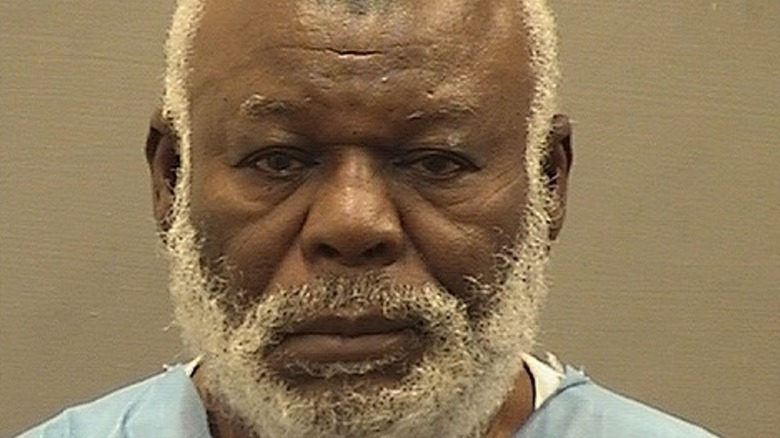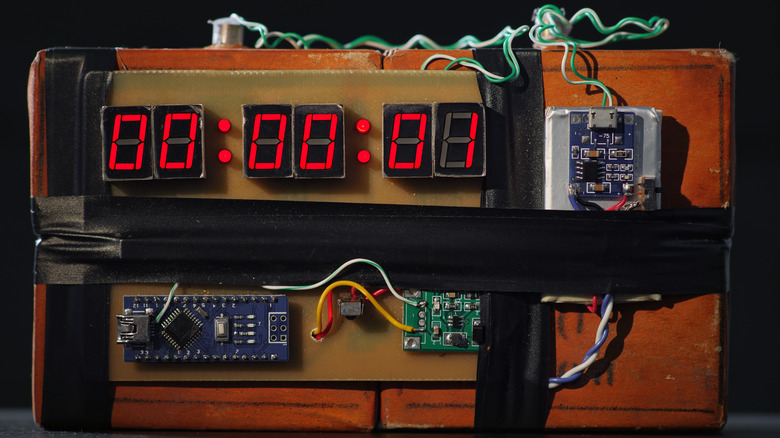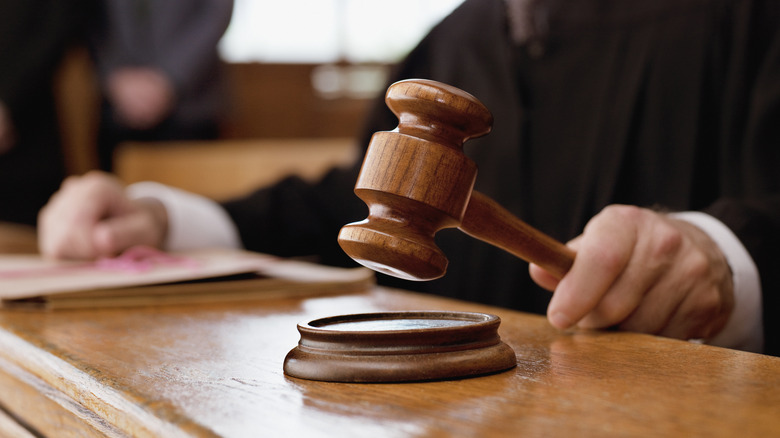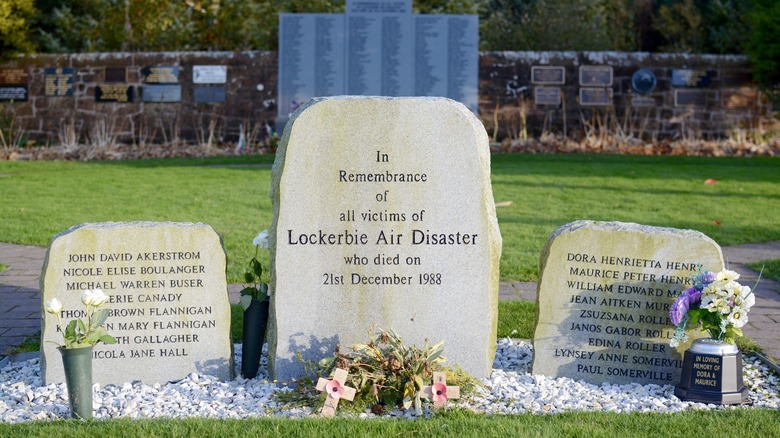Who Is Abu Agila Mas'ud, A Suspect In The Lockerbie Bombing?
At 6:25 p.m. on December 21, 1988, Pan Am Flight 103 departed from Heathrow Airport in London, England. With only four days to go until Christmas, the flight was packed with 259 passengers and crew members (via BBC). Passengers were on their way to JFK Airport in New York City, perhaps to see loved ones for the holidays or catch a glimpse of the tree at Rockefeller Center on vacation. Less than half-an-hour into the flight, the plane crossed the border of England and Scotland. By 7:03, as the BBC recounts, the flight "disappeared from radar screens." There was "no distress call," followed by nothing but radio silence. Pan Am Flight 103, simply put, had vanished.
But to people living in the small Scottish town of Lockerbie, it was clear and obvious what happened to Pam Am Flight 103, at least after the fact. Residents like Peter Giesecke, Marjory McQueen, and Father Patrick Keegans all recall different pieces of the same story: thunder like a boiler growing louder and louder; "a deep rumbling sound"; an orange sky and "flames hundreds of feet up into the air"; balls of fire descending onto their town and exploding. People like Father Keegan's mother, shielded behind a fridge door, were lucky. Many more were not, as pieces of Pam Am Flight 103 crushed houses, streets, and yards. But now, as sites like NBC News report, we just might have found the one who built the bomb that went off on the plane to begin with: Libya's Abu Agila Mas'ud.
A town torn apart
In the end, every single person on Pan Am Flight 103 died, as well as 11 residents living in Lockerbie, including an entire family of four. The passenger list included 190 Americans, 43 British citizens, and 19 individuals from various other countries. As NBC News continues, fragments of the plane — fuselage, engine, nose cone, wings, fuel tanks — fell on an 845-square-mile area, while the main impact point left behind a 150-foot-deep hole like a bomb crater. Lockerbie's town hall and skating rink were used to house the dead, per BBC. Resident George Stobbs witnessed the immediate aftermath of the crash and saw the remains of 60 people dragged out of one section of the plane partly "buried in the garden."
Media swarmed the scene. Investigations began. Scotland and the world mourned. It took until 2001 for the first conspirator in the bombing to face justice: Abdelbaset al-Megrahi, a Libyan intelligence officer (via NBC News). While we don't know his precise role in the terrorist plot to bomb Pan Am Flight 103 — the most deadly terrorist attack in the U.K.'s history — we know that he likely worked in tandem with a group of individuals during the reign of Libyan revolutionary turned tyrant Muammar Gaddafi. Over the course of his life, Gaddafi was charged with multiple war crimes by the International Criminal Court in The Hague, Netherlands, and was eventually killed by a mob in 2011, as the BBC recounts.
An alleged Libyan intelligence conspiracy
Back in 2001, Abdelbaset al-Megrahi was convicted of 270 counts of murder and given a life sentence, as NBC News recounts. This was far from the end of the story of Pan Am Flight 103, though, and not even the end of al-Megrahi's story. He'd been identified by a shopkeeper in the small Mediterranean island of Malta, who testified that al-Megrahi had bought clothes found in the Samsonite suitcase that had housed the bomb on the plane. The bomb, as the BBC describes, was hidden in the cassette recorder of a Toshiba radio that itself was stuffed into the suitcase. The suitcase had made its way on board when Pan Am Flight 103 stopped over in London en route from Frankfurt, Germany.
Al-Megrahi proclaimed his innocence right until his death in 2012. He only served eight-and-a-half years in a Scottish prison before being released "on compassionate grounds" after receiving a diagnosis of prostate cancer. To this day, his family is attempting to get his conviction overturned. They cite "uncertainties and qualifications" in al-Megrahi's testimony, per the American Society of International Law.
Meanwhile, the same year al-Megrahi died — 2012 — another Libyan man, Abu Agila Mas'ud (above), confessed to building the bomb itself and carrying out the whole terrorist plot along with two other individuals (via NBC News). This happened after he'd been brought in for questioning following the attack on the U.S. Consulate in the Libyan city of Benghazi. This was also the year after Muammar Gaddafi died.
Testimony called into question
As NBC News says, the United States Justice Department charged Abu Agila Mas'ud in December 2020 with two counts of crimes related to "working in various capacities for Libyan intelligence services, including as a technical expert in building explosive devices, from approximately 1973 to 2011." The court is also taking into account the testimony Mas'ud gave back in 2012 following the attacks committed against the U.S. Consulate in Benghazi, when he'd made a confession about his involvement in bombing Pan Am Flight 103. Mas'ud also claims that Muammar Gaddafi personally thanked him following the attack. Author John Ashton, however, questions the validity of Mas'ud's entire confession given the non-functional state of the Libyan legal system following Muammar Gaddafi's death.
There's also some confusion regarding how Mas'ud came into U.S. custody. As The Guardian says, Mas'ud spent the last 10 years in Libyan jail for "crimes committed as an intelligence operative" during Gaddafi's reign. He was released six months ago and was "just at home," a Libyan official said. It's unclear precisely how he made his way from Libya to U.S. soil, but The Guardian reports that an undisclosed source told them that the transfer was approved three months prior to December 2022. There have been further complaints about the legality of the transfer, however, especially as it relates to U.S. overreach and apparent disregard for Libya's "legal process," per Jalel Harchaoui, associate fellow at the Royal United Services Institute, a U.K.-based think tank.
Calling for a fair and just trial
Beyond such information, there's little we know about Abu Agila Mas'ud himself. In a vie to engender sympathy, The Guardian describes him as "75 and seriously ill." Another article from The Guardian says the U.S. accused him of being the one who set the timer on the bomb. The BBC also states that one of the official charges levied against him is "destruction of aircraft resulting in death."
The BBC describes Mas'ud limping his way into his initial courtroom hearing wearing a "teal prison jumpsuit" and medical mask. His charges were read to him in Arabic, and Mas'ud replied, "I can't talk until I've spoken to my attorney." Additionally, Mas'ud has "rejected the offer of free representation from the public defender's office." He also has to remain in jail until December 27 before his next hearing. If convicted, Mas'ud could face a variety of punishments for each of his charges: life in prison, a fine of up to $250,000, or the death penalty. But according to the BBC, U.S. prosecutors said that they "would not seek death" because the death penalty was "not legally available at the time of his alleged crime."
Individuals such as Dr. Jim Swire advocates Mas'ud facing his trial in a location unconnected with the original crime in order to maintain objectivity, as the BBC reports. Swire's daughter Flora died in the bombing. Now that Mas'ud's initial U.S.-based hearing is done, it's possible that the United Nations could choose an alternative location for his follow-up appearances in court.
Finishing the story
Today, Lockerbie looks like nothing more than a quaint, well-put-together town with not a blemish to be seen — or any evidence at all of the disaster in 1988 besides memorials to the dead (seen above). And yet, those who lived through the events of December 21, such as resident Marjory McQueen, state that Lockerbie is all but defined by the bombing of Pan Am Flight 103 and its 270 deaths. "I really, really felt that what Lockerbie was about was ... looking after the people who so tragically lost their lives here," she said on the BBC. "And that's what we want to be remembered for."
For his part, resident Father Patrick Keegans said, "For those of us who experienced Lockerbie, Lockerbie's story will never come to an end. Lockerbie lives with us, we're part of Lockerbie and Lockerbie's part of us. All aspects of Lockerbie stay with us. The horror, the tragedy, the sadness, the grief, the support and love that was shown. All of that stays with us." Other individuals like Reverend John Mosey, however, question the trial itself, saying on the BBC, "What is he doing in America? This was a crime committed above Scottish soil." Meanwhile, Kara Weipz, sister of a victim, said, "This is a terrorist attack against America too — the second largest in our history. I think that it's very important for us to have this trial in the US under our laws — it means everything to the US families."





